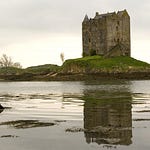Welcome back to "A Scottish Castle, A Day," brought to you by bagtownclans.com. I’m your host, Colin MacDonald, and today we’re traveling to the iconic Dumbarton Rock, home to one of Scotland’s most historic strongholds, Dumbarton Castle. Nestled on the banks of the River Clyde, Dumbarton Castle boasts a remarkable history that spans millennia—from ancient Britons to Vikings, Romans, and Scottish kings. Dumbarton has witnessed battles, sieges, royal intrigues, and has stood the test of time as one of Scotland’s most significant fortresses.
Dumbarton Rock is a natural wonder in itself. Rising 240 feet high, this volcanic plug of basalt is a relic from the Early Carboniferous period, formed between 330 and 340 million years ago. Its strategic location made it an ideal stronghold, overlooking the Clyde and providing commanding views of the surrounding landscape. The castle that sits atop this mighty rock has played a central role in Scotland’s military and political history for over 1,500 years.
The earliest records of human settlement here date back to the Iron Age. Dumbarton, known as "Alt Clut" in Brythonic, meaning "Rock of the Clyde," was the seat of the ancient Kingdom of Strathclyde. By the 5th century, it was the center of a powerful Brythonic kingdom, and Saint Patrick himself corresponded with King Ceretic of Alt Clut, as recorded in historical documents. The fortification grew in importance through the centuries, becoming a coveted prize for invaders and defenders alike.
The castle’s connection to myth and legend is also notable. Some stories suggest that Merlin, the famed wizard of Arthurian legend, stayed at Alt Clut, which Geoffrey of Monmouth immortalized in his "Historia Regum Britanniae." Whether true or not, the castle’s historical significance is undeniable.
One of the most dramatic periods in Dumbarton's early history occurred in 870 AD, when Viking kings Amlaíb and Ímar besieged the fortress for four months. Dumbarton fell after its water supply failed, and the victorious Vikings took captives back to Ireland. This marked the end of Dumbarton’s role as the capital of the Kingdom of Strathclyde, with the kingdom’s center shifting upriver to Govan.
During the medieval era, Dumbarton Castle was a vital stronghold for Scottish kings. It played a prominent role in the Wars of Scottish Independence. One of its more infamous moments came in 1305 when Sir John Menteith, the castle’s governor, betrayed William Wallace, handing Scotland’s national hero over to the English. This act of treachery has forever linked Menteith’s name with infamy, even though his later military service, particularly at Bannockburn, somewhat rehabilitated his reputation.
The castle’s strategic importance was recognized by the Romans, the Norse, and later by the English and Scots. In the 13th century, Edward I of England tried to wrest control of Dumbarton during his campaigns to dominate Scotland. During the tumultuous reign of Mary, Queen of Scots, Dumbarton Castle became a stronghold of support for her cause. After her defeat at the Battle of Langside in 1568, Mary attempted to flee to Dumbarton for sanctuary but was forced to escape to England, marking the end of her rule in Scotland.
One of the castle’s most daring moments came in 1571 when Captain Thomas Crawford of Jordanhill led a night assault to recapture the fortress from supporters of Mary, Queen of Scots. Using ladders to scale the sheer cliffs under cover of darkness, Crawford’s men surprised the garrison and took the castle in one of the boldest sieges in Scottish history.
Dumbarton Castle’s importance didn’t diminish with the medieval period. It became a key garrison during the Jacobite risings of the 18th century and even saw military use during World War II. Though much of the medieval structure has since vanished, the 18th-century fortifications still stand today, providing a glimpse into Scotland’s past military defenses.
One of the most enduring features of Dumbarton Castle is its connection to Sir William Wallace. After his capture, Wallace was briefly held here before being sent to London for trial and execution. Wallace’s sword, which was repaired at the castle in 1505, remains an important artifact, symbolizing the castle’s deep ties to Scotland’s struggle for independence.
Despite its many military engagements, Dumbarton Castle also served as a royal residence, particularly for King James IV. The king was so fond of Dumbarton that he used it as a base for his navy and frequently visited the castle. One of the most curious entries in the castle’s historical records is from 1495, noting that a piper from Dumbarton was paid for his services by the king—a testament to the castle’s lively history beyond the battlefield.
Today, Dumbarton Castle remains a powerful symbol of Scotland’s resilience. Though no longer a seat of power, its walls still echo with the stories of ancient warriors, betrayed heroes, and royal intrigue. The 557 steps leading to the summit of Dumbarton Rock offer visitors panoramic views of the Clyde and beyond, making it a must-see for history buffs and adventurers alike.
Thanks for tuning in to today’s episode of "A Scottish Castle, A Day." Join us tomorrow as we uncover another hidden gem of Scotland’s storied past. Until then, slán go fóill!











